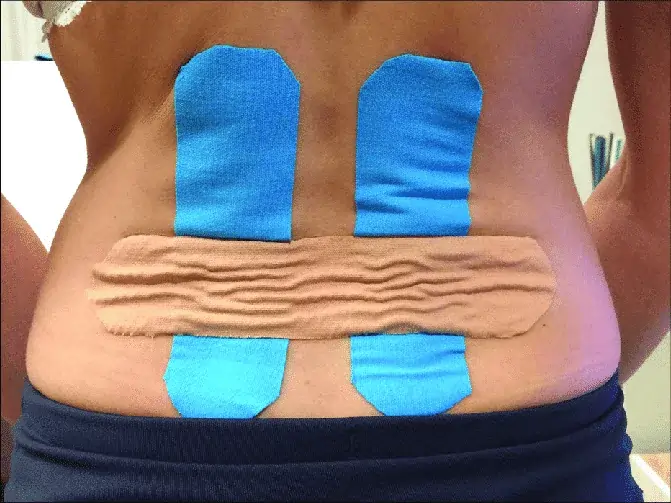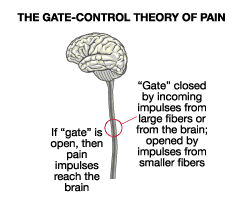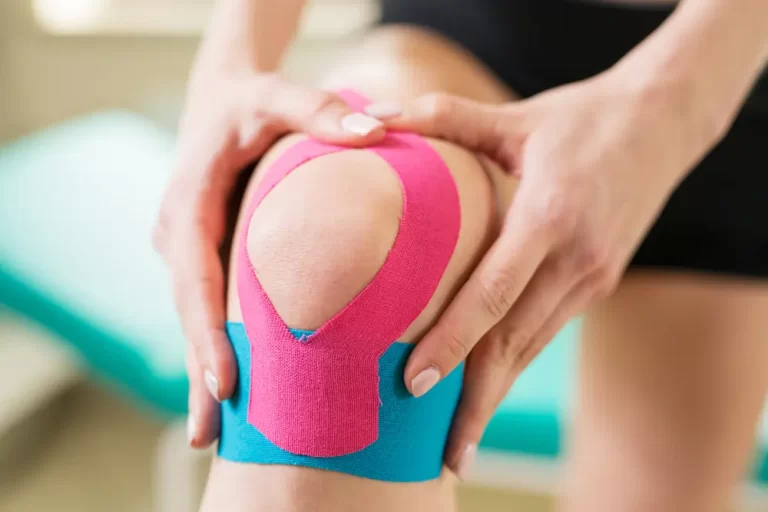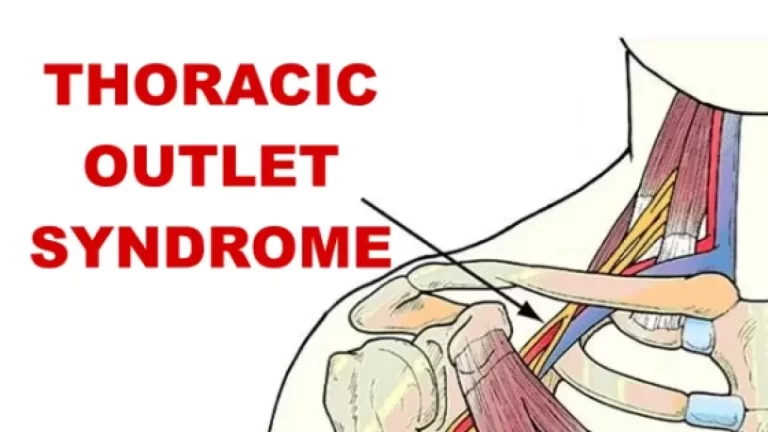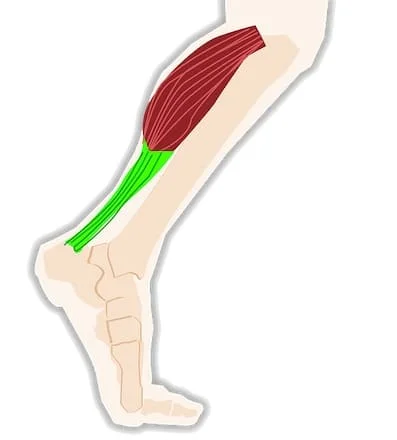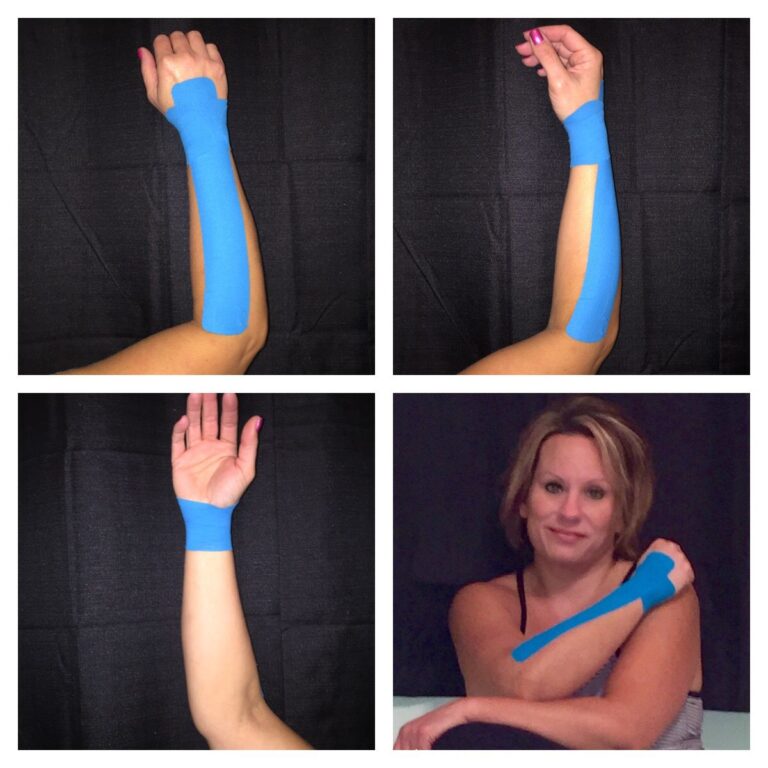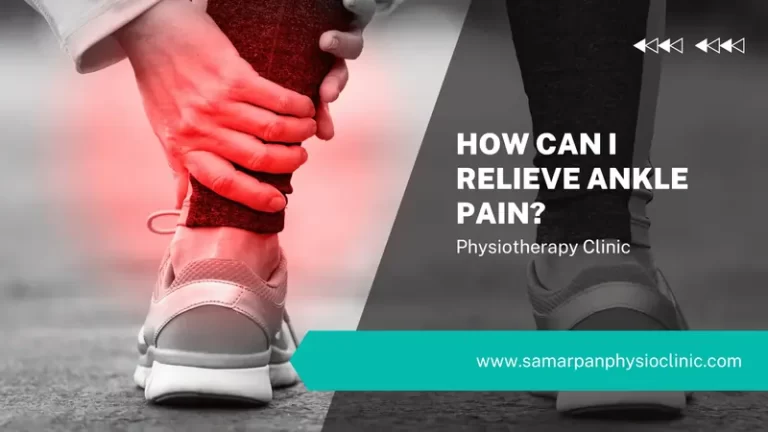TAPING TECHNIQUE FOR BACK PAIN
Table of Contents
Introduction:
Taping for back pain is most used technique to relive pain and further support to the involved area of back. This is most effective and supportive treatment for back pain. It is give static as well as dynamic support to the back.
Kinesio taping give dynamic support to the involved area while typical taping give static support to the involved area of treatment.
it is also called kinesiology tape or kinesiology therapeutic tape. is an elastic cotton strip with an acrylic adhesive that is purported to ease pain and disability from athletic injuries and a variety of other physical disorders.
Taping on your back can help stabilize it when you are active and can give relief from pain. it is most popular technique. mostly use in sport injuries because during playing any sport back injury are very common and back more prone to injured. it is because of sudden thrust on back or twisting of the back during the sport. back pain is very common in weight lifting sports.
Kinesiological tapping could be a rehabilitative cum protecting use of elastic kinesiological tapes to supply:
- reduction in back pain whereas any back injury
- enhancing performance of affected back area
- preventing any injuries to the back
- support to the back
- repositioning of structure of back
- facial and ligamentous correction of the back.
- Lower back pain is very common. It can result from a strain (injury) to muscles or tendons in the back. Other causes
- include arthritis, structural problems and disk injuries. Pain often gets better with rest, physical therapy and medication.
- Reduce your risk of low back pain by keeping at a healthy weight and staying active.
- Back pain can have causes that are not due to underlying disease. Examples include overuse such as working out or lifting too much, prolonged sitting and lying down, sleeping in an uncomfortable position or wearing a poorly fitting backpack.Back strains and sprains are the most common cause of back pain. You can injure muscles, tendons or ligaments by lifting something too heavy or not lifting safely. Some people strain their back by sneezing, coughing, twisting or bending over.
- Low back pain can result from many different injuries, conditions or diseases most often, an injury to muscles or tendons in the back.
- Back pain is pain felt in the back. Back pain is divided into neck pain (cervical), middle back pain (thoracic), lower back pain (lumbar) or coccyges (tailbone or sacral pain) based on the segment affected. The lumbar area is the most common area affected.An episode of back pain may be acute, sub-acute, or chronic depending on the duration.
- The pain may be characterized as a dull ache, shooting or piercing pain, or a burning sensation. Discomfort can radiate into the arms and hands as well as the legs or feet, and may include numbness, or weakness in the legs and arms.
- Back pain is one of most common reasons people see a doctor or miss days at work. Even school-age children can have back pain.
- Back pain can range in intensity from a dull, constant ache to a sudden, sharp or shooting pain. It can begin suddenly as a result of an accident or by lifting something heavy, or it can develop over time as we age. Getting too little exercise followed by a strenuous workout also can cause back pain.
- Back pain is and likely will continue to be the focus of many providers because of the profound effect it has on patients’ well-being. Function becomes impaired, activities of daily living are changed to accommodate back pain, and quality of life suffers.
Back pain classify in three types:
There are three categories: chronic, acute and sub acute back pain.
1.Chronic back pain (CLBP): is defined as low back pain persisting for longer than 7-12
weeks, or after the period of healing or recurring back pain that intermittently affects
an individual over a long period of time.
2.Acute back pain: is defined as low back pain lasting for less than 12 weeks.
3.Sub acute pain: is defined low back pain lasting between six weeks and three months.
Anatomy of back:
Spine:
The spine is composed of 33 bones called vertebrae, which stack together to form the spinal canal. This protects the spinal cord inside.
Facet joints connect each vertebra, with fluid supporting the free movement of these joints. A disk sits in-between each vertebra to cushion the bones from any shocks.
The spine consists of five sections. From the top of the spine to the bottom, these sections are:
- The cervical spine: The cervical spine is the top part of the spine. It runs from the neck to the upper back. It consists of seven vertebrae. The cervical spine protects the nerves connecting to the brain, allowing the head to move freely while supporting its weight.
- The thoracic spine: The thoracic spine is the middle part of the spine, connecting the cervical and lumbar spine. It has 12 vertebrae. The thoracic spine helps keep the body upright and stable.
- The lumbar spine: The lumbar spine is the lower part of the back. It is made up of five larger vertebrae. These support most of the body’s weight.
- The sacrum: The sacrum is the bottom part of the spine, which connects to the hip bones. The sacrum has five vertebrae fused together.
- The coccyx:
- The coccyx is the base, or tailbone, of the spine. This consists of four vertebrae fused together. It joins to ligaments and muscles around the pelvis.
- Ligaments are tough, flexible bands of connecting tissue that join bones to other bones.
- Two of the main ligaments in the back are the anterior longitudinal ligament and the posterior longitudinal ligament. These two ligaments connect and support the spine from the neck to the lower back.
Spinal cord:
The spinal cord runs from the neck down to the lower back. It consists of nerves that carry messages to and from the brain.
More specifically, the spinal cord allows the body to:
- move freely
- have an awareness of the position of limbs
- feel sensations, such as heat, cold, and vibrations
- regulate body temperature, blood pressure, and heart rate
- carry out bodily functions, such as breathing, urinating, and having bowel movements
- The spinal cord has five sections of spinal nerves branching off. These are:
- 1. the cervical nerves
- 2 The thoracic nerves
- 3 The lumbar nerves
- 4 .the sacral nerves
- 5. the coccygeal nerves
Muscles in the back:
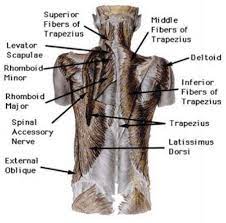
There are three different groups of muscles in the back. These are called the superficial, intermediate, and intrinsic muscles. The sections below cover these in more detail.
Superficial muscles: The superficial, or extrinsic, back muscles allow for the movement of the limbs. These muscles include the:
- trapezius
- latissimus dorsi
- levator scapulae
- rhomboids
Intermediate muscles:
The intermediate muscles connect to the ribs and support respiration. These muscles include the serratus posterior inferior and the serratus posterior superior.
Intrinsic muscles:
The intrinsic, or deep, muscles allow for movements such as rotation and bending. These muscles include:
- the iliocostalis
- the longissimus
- the spinalis
- the semispinalis
- the multifidus
- the rotatores
Causes of back pain:
Most acute low back pain is mechanical in nature, meaning that there is a disruption in the way the components of the back (the spine, muscle, intervertebral discs, and nerves) fit together and move. Some examples of mechanical causes of low back pain include:
Congenital:
- Skeletal irregularities such as scoliosis (a curvature of the spine), lordosis (an abnormally exaggerated arch in the lower back), kyphosis (excessive outward arch of the spine), and other congenital anomalies of the spine.
- Spina bifida which involves the incomplete development of the spinal cord and/or its protective covering and can cause problems involving malformation of vertebrae and abnormal sensations and even paralysis.
Injuries:
- Sprains (overstretched or torn ligaments), strains (tears in tendons or muscle), and spasms (sudden contraction of a muscle or group of muscles) Traumatic Injury such as from playing sports, car accidents, or a fall that can injure tendons, ligaments, or muscle causing the pain, as well as compress the spine and cause discs to rupture or herniate.
Degenerative problems:
- Inter vertebral disc degeneration which occurs when the usually rubbery discs wear down as a normal process of aging and lose their cushioning ability.
- Spondylosis the general degeneration of the spine associated with normal wear and tear that occurs in the joints, discs, and bones of the spine as people get older. Arthritis or other inflammatory disease in the spine, including osteoarthritis and rheumatoid arthritis as well as spondylitis, an inflammation of the vertebrae.
Nerve and spinal cord problems:
- Spinal nerve compression, inflammation and/or injury Sciatica (also called radiculopathy), caused by something pressing on the sciatic nerve that travels through the buttocks and extends down the back of the leg. People with sciatica may feel shock-like or burning low back pain combined with pain through the buttocks and down one leg.
- Spinal stenosis, the narrowing of the spinal column that puts pressure on the spinal cord and nerves.
- Spondylolisthesis, which happens when a vertebra of the lower spine slips out of place, pinching the nerves exiting the spinal column Herniated or ruptured discs can occur when the intervertebral discs become compressed and bulge outward Infections involving the vertebrae, a condition called osteomyelitis the intervertebral discs, called discitis or the sacroiliac joints connecting the lower spine to the pelvis, called sacroiliitis.
- Cauda equina syndrome occurs when a ruptured disc pushes into the spinal canal and presses on the bundle of lumbar and sacral nerve roots. Permanent neurological damage may result if this syndrome is left untreated.
- Osteoporosis (a progressive decrease in bone density and strength that can lead to painful fractures of the vertebrae).
Non-spine sources:
Kidney stones can cause sharp pain in the lower back, usually on one side Endometriosis (the buildup of uterine tissue in places outside the uterus) Fibromyalgia (a chronic pain syndrome involving widespread muscle pain and fatigue) Tumors that press on or destroy the bony spine or spinal cord and nerves or outside the spine elsewhere in the back Pregnancy (back symptoms almost always completely go away after giving birth)
Risk factors:
Anyone can have back pain. Factors that can increase the risk for low back pain include:
1. Age:
The first attack of low back pain typically occurs between the ages of 30 and 50, and back pain becomes more common with advancing age. Loss of bone strength from osteoporosis can lead to fractures, and at the same time, muscle elasticity and tone decrease. The intervertebral discs begin to lose fluid and flexibility with age, which decreases their ability to cushion the vertebrae. The risk of spinal stenosis also increases with age.
2 .Fitness level:
Back pain is more common among people who are not physically fit. Weak back and abdominal muscles may not properly support the spine. “Weekend warriors”—people who go out and exercise a lot after being inactive all week—are more likely to suffer painful back injuries than people who make moderate physical activity a daily habit. Studies show that low-impact aerobic exercise can help maintain the integrity of intervertebral discs.
3. Weight gain:
Being overweight, obese, or quickly gaining significant amounts of weight can put stress on the back and lead to low back pain.
4 .Genetics:
Some causes of back pain, such as ankylosing spondylitis (a form of arthritis that involves fusion of the spinal joints leading to some immobility of the spine), have a genetic component.
Job-related factors: Having a job that requires heavy lifting, pushing, or pulling, particularly when it involves twisting or vibrating the spine, can lead to injury and back pain. Working at a desk all day can contribute to pain, especially from poor posture or sitting in a chair with not enough back support.
5. Mental health:
Anxiety and depression can influence how closely one focuses on their pain as well as their perception of its severity. Pain that becomes chronic also can contribute to the development of such psychological factors. Stress can affect the body in numerous ways, including causing muscle tension.
6 .Smoking:
It can restrict blood flow and oxygen to the discs, causing them to degenerate faster.
Backpack overload in children: A backpack overloaded with schoolbooks and supplies can strain the back and cause muscle fatigue.
7. Psychological factors:
Mood and depression, stress, and psychological well-being also can influence the likelihood of experiencing back pain.
Symptoms:
The main symptom of back pain is an ache or pain anywhere in the back, and sometimes all the way down to the buttocks and legs.
Some back issues can cause pain in other parts of the body, depending on the nerves affected.
The pain often goes away without treatment, but if it occurs with any of the following people should see their doctor:
- weight loss
- fever
- inflammation or swelling on the back
- persistent back pain, where lying down or resting does not help
- pain down the legs
- pain that reaches below the knees
- a recent injury, blow or trauma to the back
- urinary incontinence
- difficulty urinating
- fecal incontinence, or loss of control over bowel movements
- numbness around the genitals
- numbness around the anus
- numbness around the buttocks
Special test for back pain:
- Forward bend test:
Stand up straight with your hands at your side.bend forward and reach to your toes as far as you can go.
Negative test-Your back pain does not get worse when you bend over at the wrist.
Positive test- If your pain gets worse when bending over the test is positive.
What does a positive test mean ?
When performing the test if the pain goes down the back of the leg. your pain might be caused by a disc irritation a nerve root irritation or a facet joint irritation.
2.Quadrant test:
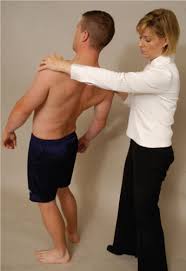
Stand up straight with your hand your wist.bend your spine backward (extension) then side bend and rotate to the side of your spine.that you have pain repeat this on the opposite side as well.
Negative test-This test is negative if the position does not reproduce your pain.
Positive test- If you get into the testing position and the test reproduce your low back pain.
What does a positive test mean ?
If the pain stays in your low back ,it means that your back pain is likely being caused by some kind of facet joint irritation these are the small joint’s on either side of your spine if the pain occurs in the top of the hip or down the leg.
it means that there is likely pressure being put on the nerve roots are coming out of your spinal cord.
3. Slump test:
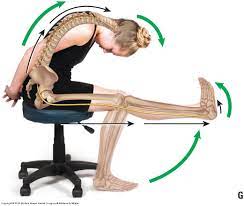
Sit at the edge of a table or chair. slouch over and tuck your chin down to your chest bring one of your ankles into dorsiflexion (bring your toes up towards your nose). straighten your knee until you feel a pull any where from your low back to the bottom of your foot. most people will feet a pull behind the knee once you feel a pull look up towards the ceiling.
Negative test : This test is negative when lifting your head does not decreases the stretch /pull/pain in the back of the leg when you lift your head up.
Positive test: This test is positive when lifting your head up relieves the pain by at least 50%.
What does a positive test mean?
A positive slump test means that the nerve running from your back to your foot have some kind of pressure on them and/or are not moving smoothly in he path that they travel. A positive test does not indicate nerve damage only that movement of the nervous system is restricted.
Taping for back pain:
There is two type of taping for back pain:
- Taping used in employed in the field of rehabilitation as a method of treatment for back injuries but much of the evidence is contradictory. Taping is one among the adjunct treatments that we have a tendency to as physiotherapists would possibly use with our patients together with well supported techniques like patient education and exercise therapy.
- we have a tendency to could argue that if tape includes a positive impact, be it placebo or mechanical, then we must always use it. provides a firm support, holds and reduces movement of a joint with a powerful and sticky material, examples include Strappal or Endura Fix.
- Rigid strapping tape usually used in tape or strapping is commonly referred to as “sports tape” or “athletic tape” and is most frequently a rigid type of strapping tape. Elastic husky tape may be used once less rigidity or support is needed.
Rigid taping:
Rigid strapping is most commonly applied before training, or a match, and is designed to stabilize a joint and support tendons and ligaments attachments. Muscle injuries and support is generally better treated with rigid tape, K-Tape or Cohesive tape.
- Over-taping the joint and/or taping too often can sometimes lead to other injuries, as other joints and muscles can be forced to compensate for the injured area and it’s lack of natural movement. Always seek professional medical advice for injuries.
- All tapes work best on dry skin surfaces. Avoid moisturizing the skin and very hairy skin as this will form a barrier and adversely affect the adhesive qualities of any tape.
- Rigid tape sticks better to itself than to skin, so overlapping tapeon-tape, or fixing onto a tape anchor works best. Rigid tape is non-stretchy. Try to handle and place the tape carefully to avoid creasing the tape wherever possible.
Application of rigid tape:
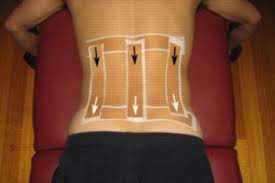
- Hypo allergic under tape 50-mm strapping tape used over taping area before the rigid tape was applied.
- Subjects were in a lying prone or standing position whereas the Patient must be able to achieve a relaxed and pain-free extended lumbar posture (lordosis) while the tape was being applied and the tape was retained for 48 hours before changing to the next session.
- The spine is neutral to a slightly extended position with lumbar curvatures maintained,anchor strips were applied to the top and bottom of the area to be taped. An X was formed across the lumbar region from the top anchor to the bottom anchor, with the centre of the X overlying the L2–3 region.
- The top and bottom of the X were then re-anchored. Movements were assessed for pain-free range of motion in flexion and side flexion.
Kinesio tape:
Kinesio Taping Method is a therapeutic tool utilised by the rehabilitation specialists in all programs (paediatric, geriatric, orthopaedic,neurological, oncology and others) and levels of care (acute care, inpatient rehabilitation, outpatient, home care and Day Rehab). The idea of using elastic tape to mimic the therapist’s hands was first presented by Dr Kenzo Kase in the 1970s.
Application of Kinesio taping:
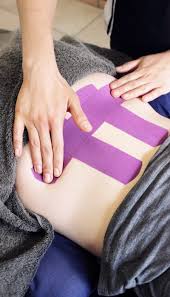
- 1 Measure and cut a Y STRIP from PSIS to the mid-point of the spine.
- If you’re unsure how to cut a Y STRIP, see our ‘Taping Techniques’ video.
- Lay the base of the Y STRIP directly over PSIS with no tension.
- 2 Place the back into lumbar flexion and left side flexion.
- The most effective way to do this is in 4 point kneeling, however you can also just bend forward in standing if it’s easier.
- Lay one half of the Y STRIP down along the line of Erector Spinae with no tension.
- Repeat on the opposite side and return the patient to a neutral spine position.
- 3 Cut another small strip of tape, measured between the 2 tails of your Y STRIP.
- Rip the backing paper into 3, and remove the middle section.
- Stick the tape directly across point of pain with 50-75% tension.
- Stick the ends of the strip down with 0% stretch, this will help to prevent excessive recoil.
- Wait at least 30 minutes before exercise.
How to remove tape?
- So presently you’ve got your tape on and you’ve gotten that additional support throughout your chosen sporting activity, it’s time to need it off, so enable the United States to ease the tactic of removing physiology tape for you.
- The foremost effective tip we are going to provide once it involves removing your physiology tape is to peel the skin from the tape, not the tape from the skin.
- But in terms of the actual methodology, 1st ensure you’re removing the tape in an equivalent direction as a result of the expansion of the hair below it, and despite what you’re doing don’t rip the tape off kind of a plaster!
- Start slowly, folding the corners of the sting back bit by bit, guaranteeing that you’re birth the removed tape on the rear of the applied tape, as opposition propulsion the tape on top of and aloof from your arm.
- As you’re scraping the tape, hold your skin down beside your completely different hand and either regulator it or pull it gently among the opposite means of the tape. This helps the skin and so the tape to separate heaps expeditiously but with no discomfort.
- If the tape has been applied over a furred region of the body, it helps to maneuver on the tape as you are peeling it off, as a result of the pressure helps avoid a lot of pain.
- It’s knowing have shaved the realm before applying the tape but, as this isn’t frequently smart, taking this precaution square measure reaching to be necessary to some.
- want a bit additional assistance? Apply oil directly onto the tape, rub it in and wait around 10 to twenty minutes before removing it slowly. This will facilitate reducing the viscousness of the tape and build it easier to induce obviate.

